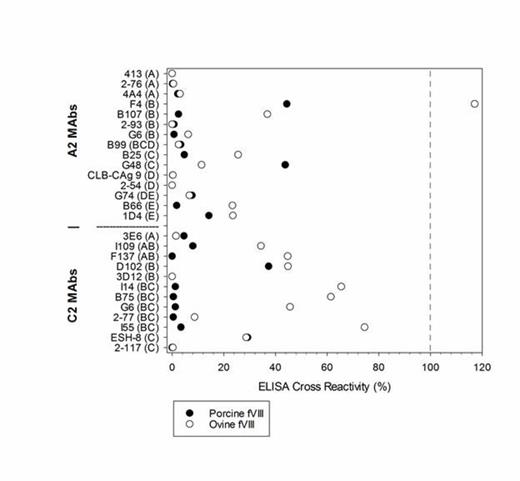Abstract
Approximately 20-30% of severe hemophilia A patients develop inhibitors (anti-fVIII antibodies) to human fVIII (hfVIII) with the primary targets being the A2 and C2 domains. Studies of A2 domain-specific murine monoclonal antibodies (MAbs) targeting hfVIII identified 8 distinct groups of inhibitory MAbs displaying varying inhibitor titers and kinetics, with groups A, D, and E possessing the greatest inhibitory activity. Furthermore within the C2 domain, we previously characterized 5 distinct groups, whereby group BC antibodies were the most common and displayed the highest specific inhibitory activity. At present, a recombinant porcine fVIII (pfVIII) product (OBI-1, Baxter International) is being investigated within a pivotal clinical trial for persons with acquired hemophilia A. The rational for a recombinant pfVIII product stems from the limited cross reactivity of pfVIII, and potentially other fVIII orthologs, with antibodies developed against hfVIII and the prior clinical success of plasma-derived pfVIII. We have described the biochemical characterization of both pfVIII and, more recently, ovine fVIII (ofVIII) and now investigate their antigenic properties to define/refine key inhibitory epitopes and determine the amino acid differences that confer reduced antigenicity. Using an ELISA-based assay, 15 A2 and 12 C2 MAbs spanning all inhibitory groups were screened against B-domain deleted (BDD) pfVIII and ofVIII. Only 4 A2 domain targeting MAbs representing groups B, C, DE, and E were found to bind pfVIII and all displayed reduced cross-reactivity (Figure 1). Additionally, 3 MAbs within groups B, C, or E also bound ofVIII. No group A or D MAbs screened bound either ortholog. Of the C2 domain targeting MAbs tested, 3 MAbs (I109, D102, and ESH-8) from groups AB, B and C, respectively, bound pfVIII to lesser degrees. Nine of the 12 C2 targeting MAbs bound ofVIII, albeit at reduced signal strength, suggesting divergence in C2 epitopes between pfVIII and hfVIII as well as between pfVIII and ofVIII. Using these data and previous literature defining the specific epitopes of these MAbs, we suggest that species-specific amino acid sequence differences may be responsible for the differential binding. MAb413, a well characterized A2 group A inhibitor, was found not to bind either ortholog. Alanine scanning mutagenesis within the 484 – 508 epitope demonstrated that single point mutations at R484, Y487, R489, or P492 could each inhibit binding of MAb413 to below 10%. In addition, P485 or S488 mutations each reduced binding to approximately 40% (Lubin et al J Biol Chem 272:48). Both pfVIII and ofVIII share substitutions R484S, Y487H, R489G, and pfVIII contains unique substitutions P485A, S488P, and P492L. Since all but two A2 group A MAbs have been mapped to residues 484-508, and because all group A MAbs compete with each other for their epitope, we hypothesize that these substitutions are responsible for diminished binding of group A MAbs. Group D inhibitory antibodies have been mapped to residues 604-740. Within this region, there are 12 shared amino acid substitutions and 7 amino acids altered in either ortholog but not both. As it was demonstrated that the orthologs display differential cross reactivity, this suggests disparate amino acids alter inhibitor-epitope recognition. Walter et al. (J Biol Chem 2013 288:14) used small angle x-ray scattering (SAXS) to isolate the epitope of MAb 3E6, a C2 MAb group A inhibitor, to exposed loops R2209-S2216 and L2178-D2187. Our data show that this MAb is not cross reactive and both orthologs contain S2216T and S2182N substitutions. Finally, ESH-8, a well-studied C2 group C MAb, binds ofVIII and pfVIII equivalently at 29% of the hfVIII level. The epitope for ESH-8 contains amino acids 2248-2285 and within this region there is only one conserved substitution, F2275L. Therefore, we predict that substitution of this residue could restore or further diminish ESH-8 binding. These data provide evidence that the lack of A2 group A and D epitopes, as well as the C2 domain group BC epitopes within these orthologs may be responsible for the residual procoagulant activity in the context of inhibitor plasma. Furthermore, these data also suggest that 1) B-cell epitopes can be defined or refined through this approach, 2) less antigenic residues can be identified and 3) the information obtained can be utilized to rationally design recombinant fVIII products with reduced antigenicity.
No relevant conflicts of interest to declare.
Author notes
Asterisk with author names denotes non-ASH members.


This feature is available to Subscribers Only
Sign In or Create an Account Close Modal